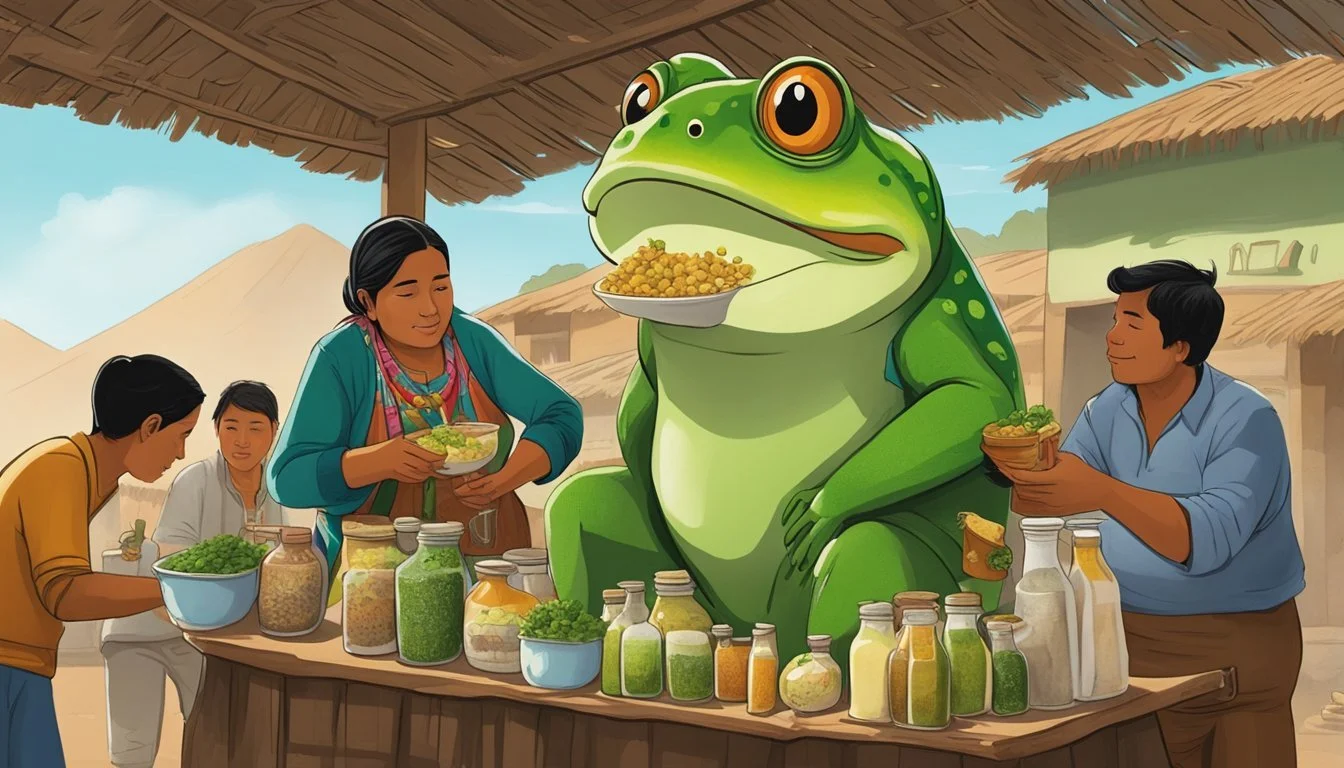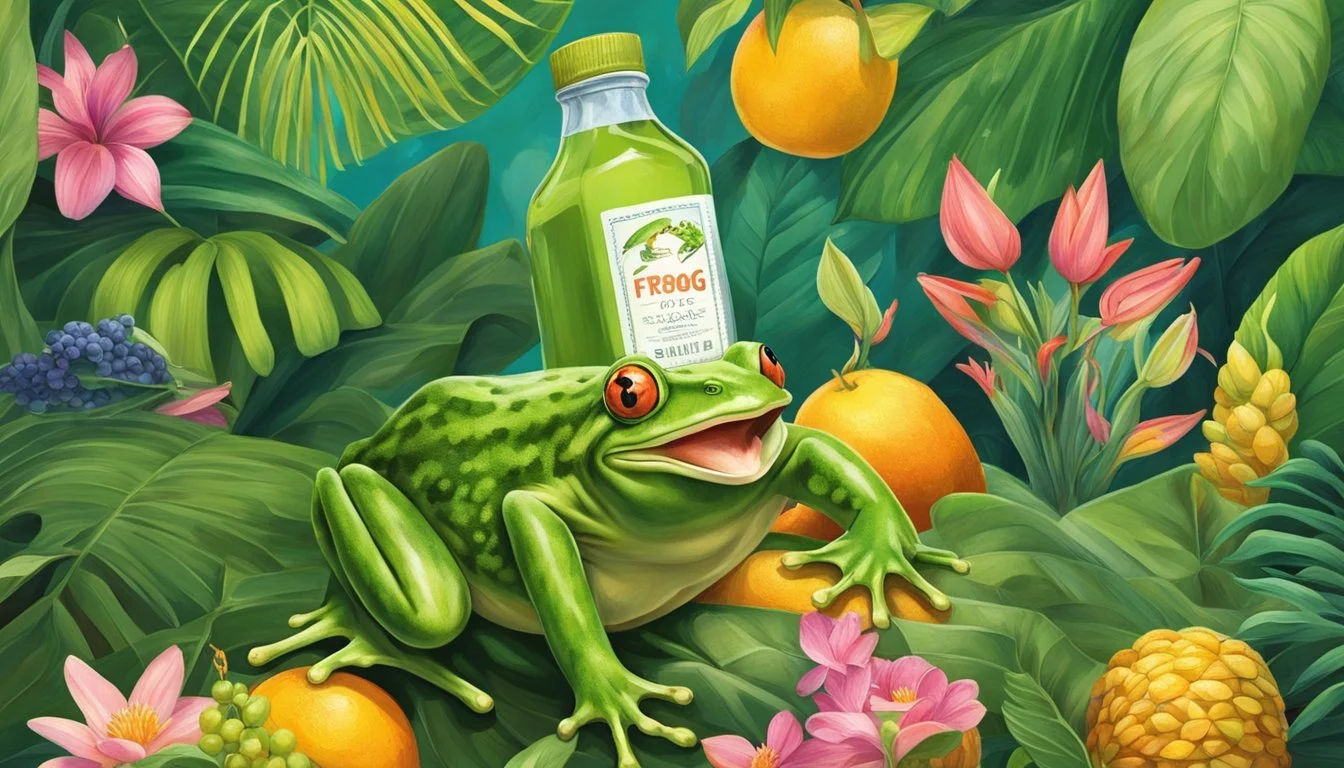Frog Juice
The Peruvian Energy Drink Providing a Unique Morning Boost
Frog juice is a unique and traditional beverage hailing from the vibrant streets of Peru. Known locally as "jugo de rana," this distinctive concoction is crafted from blending together whole frogs, typically the species Telmatobius culeus, with an assortment of ingredients like maca root, honey, and an assortment of other local herbs and vegetables. Revered for its energizing qualities, the drink has earned a place in Peruvian culture as a morning boost, commonly consumed to start the day with vitality.
In Peru, the consumption of frog juice is not just about seeking an energy surge; it's deeply intertwined with the belief in its restorative and health-promoting properties. Supporters of the beverage attest to its effectiveness in treating a range of ailments, from asthma and bronchitis to fatigue and low libido. These claims contribute to the popularity of frog juice, establishing it as a go-to remedy and a source of natural invigoration.
Despite its revered status among locals, the making of this energy drink brings to light issues concerning sustainability and animal welfare. The frogs used are often a part of the country's biodiversity, and concerns arise about the impact of their utilization on the ecosystem. Consequently, while many Peruvians swear by the benefits of frog juice, there is an ongoing conversation about the practices involved and the need for responsible sourcing and consumption.
Origin and Cultural Significance
Peruvian frog juice, known locally as "jugo de rana," is more than just a beverage; it's a storied tradition deeply ingrained in Andean culture and revered for its purported health benefits.
The Andean Tradition
In the Andes, particularly near Lake Titicaca, the Telmatobius culeus species, commonly referred to as the Lake Titicaca frog, has long been the key ingredient in this traditional energy drink. The use of this frog species is specific to the Andean region of South America. The practice involves blending the frog with other native ingredients, such as the maca root and honey. This combination is believed to have originated in these high-altitude regions where locals sought natural remedies and energy boosters to combat the harsh conditions.
Cultural Perspectives on Frog Juice
Within the Peruvian cultural context, frog juice isn't merely a health concoction; it carries a spiritual connotation as well. Many consider it a sacred beverage, passed down through generations, imbued with the ability to heal various ailments. This perception has elevated it beyond a typical drink, integrating it into the social fabric as a holistic remedy. Consumers of frog juice in Peru treat it with respect and pride, deeply valuing its connection to their history and cultural identity.
Ingredients and Preparation
The Peruvian energy drink known as frog juice is a concoction that combines an unusual protein source with traditional Andean superfoods. Prepared fresh at local stands, the beverage offers a distinct taste and an energy boost.
Key Ingredients
Frogs: The critical component is the frog, traditionally a species found in Lake Titicaca, which is blended whole after being skinned.
Maca: A potent Peruvian root with energy-boosting properties.
Honey: Added for sweetness and its natural health benefits.
Carrots and Fresh Fruit: Commonly used to enhance the juice's flavor and nutritional value.
Chia: Sometimes incorporated for additional protein and omega-3 fatty acids.
Traditional Preparation Methods
A stand or counter is the usual setting where vendors skillfully prepare frog juice. The process starts with cleaning and skinning the frog, followed by placing it in a blender. They then add finely chopped carrots, a selection of fresh fruit, and a generous helping of maca root. Honey and chia seeds are also mixed in to sweeten the drink and provide extra nutrients. Everything is blended until smooth, resulting in a beverage acclaimed for its energizing properties.
Health Claims and Uses
Peruvian frog juice is touted for its health benefits, with users claiming it aids in combating a range of ailments and in enhancing vigor and energy levels.
Reported Medicinal Benefits
Consumers of frog juice report a variety of medicinal benefits from the drink. Bronchitis and asthma are two conditions for which the drink is often recommended. It is believed to have a therapeutic effect on respiratory disorders.
Usage in Treating Conditions
The use of frog juice as a treatment spans various conditions. It is consumed to combat anemia, reputed to support in improving blood count and iron levels. Individuals also drink it to address symptoms of fatigue and its associated impacts on health.
Perceived Effects on Energy and Libido
Frog juice is commonly perceived to boost energy levels, particularly as a morning beverage. Moreover, there is a belief that it can significantly improve sex drive and counteract issues of low libido, especially among older persons. These effects contribute to its popularity as an all-natural energizing solution.
Scientific Evidence and Controversy
This section assesses the scientific evidence regarding frog juice as well as the conservation and ethical issues it presents.
Research on Frog Juice
Limited scientific research exists on the health benefits of frog juice, and it is not recognized by the FDA as a curing agent for diseases. Nonetheless, some local Peruvian consumers believe that frog juice aids with anemia, bronchitis, and fatigue. The substantiation of these claims requires rigorous studies, controlled trials, and peer-reviewed research to verify efficacy and safety.
Conservation and Ethical Considerations
The species of frog commonly used in these juices, found in Lake Titicaca, is listed as Critically Endangered by the International Union for Conservation of Nature. The harvesting of these frogs for juice is controversial due to the threat it poses to their population and the surrounding ecosystem. Conservationists stress the need for ethical sourcing practices and potential alternatives to prevent further depletion of this endangered species.
Production and Consumption
Peruvian frog juice, locally known as Jugo de Rana, is a traditional beverage claimed by many to offer health benefits. It is primarily produced and consumed in cities like Arequipa and to a lesser extent in Lima.
Popularity Among Locals and Tourists
Jugo de Rana holds an esteemed position, particularly in Arequipa, where the local population has long consumed it for its purported therapeutic properties. Food stands and vendors in the central markets of Arequipa prepare and sell this energy drink, extending its reach to tourists seeking authentic Peruvian experiences and traditional remedies. The ritual of making and drinking frog juice persists as a bridge between generations, as locals continue to embrace it for wellness, while tourists often approach it as a novel item to cross off their travel bucket list.
Variations and Modern Takes
While the core ingredients of frog juice—specifically, skinned frogs blended with maca root and honey—remain constant, vendors have introduced variations to cater to evolving consumer preferences. In some cases, additional ingredients like carrots are mixed to enhance the juice's nutritional value and flavor profile. Additionally, modern takes on this classic concoction may see it adapted for contemporary palettes, in efforts to maintain its relevance amongst both Peruvian customers and international visitors. These adaptations not only diversify the taste but also demonstrate the drink's flexibility within culinary evolution.
Health and Safety Information
This section provides critical insights into the potential health and safety considerations associated with the consumption of Peruvian frog juice.
Potential Health Risks
Peruvian frog juice, while touted for its potential health benefits, carries certain risks that consumers should be aware of. Firstly, anemia and respiratory issues are conditions often mentioned in the context of frog juice being beneficial. However, it's vital to note that there is no scientifically verified evidence to support these claims. Consumers should exercise caution and consult healthcare providers before using frog juice as a remedy.
Tuberculosis: Frogs can be carriers of diseases such as tuberculosis; therefore, consuming raw frog products could pose a threat to public health.
Protein Allergies: As frog juice contains animal protein, individuals with allergies should be wary of potential reactions.
Parasites and Bacteria: Improperly prepared frog juice could expose individuals to harmful parasites and bacteria, which are particularly dangerous for children whose immune systems may not be fully developed.
Safe Consumption Practices
When it comes to the consumption of frog juice, safety practices are essential to minimize risks.
Source Verification: Always ensure that frogs are sourced from safe, uncontaminated environments.
Preparation Hygiene: Proper cleaning and preparation of the ingredients can reduce the risk of foodborne illnesses.
Consultation with Health Professionals: Adults and children considering frog juice for health reasons should first seek advice from qualified medical professionals.
Moderation: If chosen for consumption, frog juice should be consumed in moderation as part of a balanced diet.
It is imperative for consumers to make informed decisions and follow safe consumption practices to mitigate potential health risks associated with frog juice.
Global Interest and Influence
Peruvian frog juice has transcended its traditional boundaries, catching international attention. This interest is attributed to its purported health benefits and unique cultural significance.
International Exposure
Frog juice gained international exposure as travelers and media covered the drink's prominence in Peruvian culture. This coverage illuminated the practice of using frogs from Lake Titicaca, highlighting its significance as a cultural staple with supposed medicinal properties. Notably, articles featuring individuals like Maria Elena Cruz, who prepares the juice, have contributed to this global curiosity. Aquariums and wildlife enthusiasts have also taken an interest in the species used, raising discussions on conservation and ethical sourcing.
Adaptations Outside Peru
The international community has seen various adaptations of frog juice, with some health enthusiasts and niche cafes attempting to replicate the drink. These versions often modify the recipe to comply with local wildlife regulations and availability of ingredients. Cecilia Cahuana, among others, advocates for the drink's benefits, which has spurred its adoption and adaptation, albeit on a much smaller scale compared to its consumption in Peru. However, it is important to note that these adaptations are subject to the regional acceptance and legal constraints concerning the use of amphibians.
The Future of Frog Juice
As the demand for frog juice persists, the key concerns revolve around its impact on species conservation and the spread of knowledge about its uses and implications.
Conservation Efforts
Telmatobius culeus, a species often used in the preparation of frog juice, faces endangerment due to overharvesting and environmental threats. Conservationists in Peru and neighboring Bolivia are pushing for strict measures to protect this critical species. Initiatives include captive breeding programs and habitat restoration, aiming to replenish populations in the wild. Additionally, regulations are being proposed to limit the number of frogs taken from their natural habitat.
Captive Breeding: Providing a controlled environment for breeding to increase population numbers.
Habitat Restoration: Improving the natural environment to support a sustainable frog population.
Regulation: Implementing legal measures to control the usage of frogs.
Increasing Global Awareness
As globalization introduces frog juice to a broader market, it becomes imperative to educate consumers on the ecological implications of their choices. Campaigns are underway to increase awareness of both the potential health benefits and the environmental costs. Efforts are being made to promote alternatives that do not jeopardize frog populations, such as plant-based supplements that mimic the energy-boosting effects of frog juice.
Educational Campaigns: Clarifying the health effects and ecological impact.
Promotion of Alternatives: Encouraging the use of sustainable substitutes.







